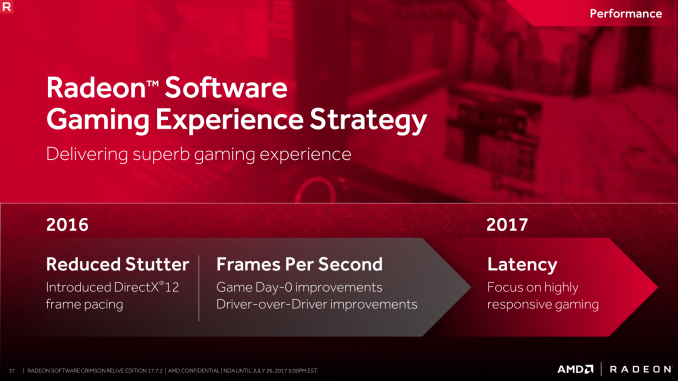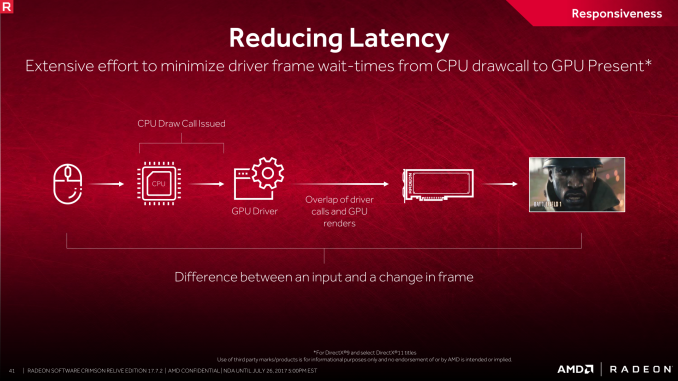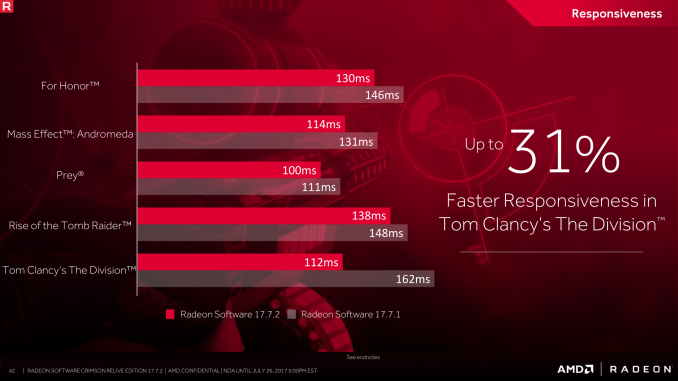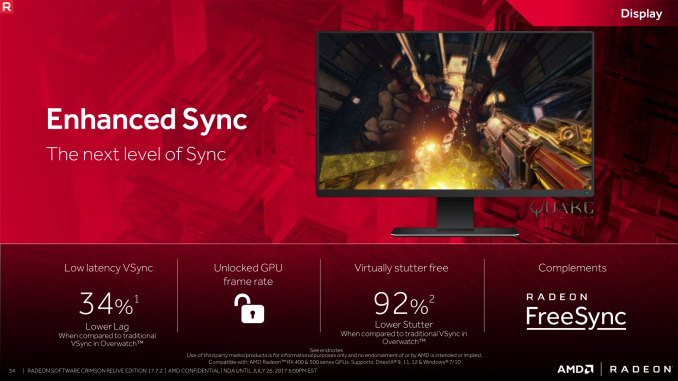AMD Releases Radeon Software Crimson ReLive Edition 17.7.2: ReLive Edition Refined for Gamers and Developers
by Nate Oh on July 26, 2017 5:00 PM ESTDeveloping a Better V-Sync: AMD Enhanced Sync
Last year, AMD had targeted stutter with DX12 frame pacing, and overall framerates with day-0/driver-over-driver improvements. For 2017, AMD is targeting input lag/responsiveness and latency, with one such method being the reduction of driver frame wait-times.
AMD has addressed such driver overheads in 17.7.2, noting increased responsiveness in certain games.
On lower latency, AMD’s major effort in 17.7.2 is introducing its latest sync technology: Enhanced Sync. The idea is that Enhanced Sync acts as an alternative lower-latency solution to V-Sync, which can cause high latency or stuttering in certain scenarios. Within Radeon Settings, Enhanced Sync is now an option under the vertical refresh drop-down menu. Because Enhanced Sync does not work for OpenGL applications, there is no interaction between Enhanced Sync and the OpenGL Triple Buffering option.
Above the refresh rate, Enhanced Sync keeps the frame rate unlocked and displays the most recently completed frame, in a manner roughly analogous to old-school triple buffering. The net result is that this reduces V-Sync’s average latency (also known as ‘input lag’) at high framerates. Though it should be noted that because a frame can only be presented at the next buffer flip, it still incurs a slight penalty to response time relative to V-Sync off, which AMD measured with a high speed camera.
Otherwise if the frame rate drops below the refresh rate, Enhanced Sync dynamically disables V-Sync falling back to V-Sync off behavior where a finished frame is immediately presented, decreasing the stutter that results from repeated frames. In turn, this does come with all of the drawbacks of having V-Sync off, namely tearing. AMD explains that enabling tearing this way is the best compromise in this situation, where low framerates typically result in only a single tearing "seam" on the screen at any given time.
For the time being, AMD is not providing any further implementation details for Enhanced Sync, and will let us know when they do. Likewise, during the slide deck presentation, AMD did not clarify if Enhanced Sync was an implementation of triple buffering when asked, citing an upcoming whitepaper on the topic. But at a glance, Enhanced Sync appears similar to a combination of NVIDIA’s Fast Sync (introduced with Pascal) and Adaptive V-Sync (introduced with Kepler). Regarding the latter, Adaptive V-Sync operates by selectively disabling V-Sync, which appears to be exactly how Enhanced Sync operates when framerates are below the refresh rate. In which case if AMD's implementation does behave similarly to NVIDIA's, then as we've already found with Fast Sync, to make the most of the technology you will need a framerate 2x (or more) higher than the refresh rate. This is because the closer the frate rate is to the refresh rate, the fewer opportunities there will be to "jump ahead" by discarding frames.
Finally, Enhanced Sync can work in conjunction with FreeSync, kicking in when framerates exceed the maximum FreeSync range. For FreeSync displays that don't support low framerate compensation (LFC), Enhanced Sync will also come into play on when framerates dip below the display's minimum FreeSync range. Enhanced Sync is officially compatible with FreeSync 2 and Radeon Chill as well, and works under DX9, DX11, and DX12 applications. Currently, Enhanced Sync is only supported on the gaming consumer driver, and thus does not support Radeon Vega Frontier Edition. Otherwise, according to Scott Wasson's accompanying Enhanced Sync blog post, Enhanced Sync is supported on the RX 400 and 500 series, as well as the upcoming RX Vega cards.

















30 Comments
View All Comments
ComputerGuy2006 - Wednesday, July 26, 2017 - link
I read the title too fast, for a second I assumed they had tweaked the radeon software interface. I miss the old interface. The one that had a hierarchy on the left and the settings on the right. It was simple, intuitive and easy to use. Even after few years I am still not comfortable using this 'touch screen' type of interface, I often find myself frustrated while using it....Cryio - Wednesday, July 26, 2017 - link
Just W7 and W10 targeted improvements? No W8.1? Seems wrong.CBRworm - Wednesday, July 26, 2017 - link
AMD doesn't support W8.1 with the RX 5xx cards.Cryio - Thursday, July 27, 2017 - link
Seriously?highlnder69 - Thursday, July 27, 2017 - link
Any particular reason you are still using Windows 8.1 over Windows 10?Alexvrb - Thursday, July 27, 2017 - link
Computer plugged in, check. Display connected, check. Modern system with latest-gen discrete graphics, check. Free Windows 10 upgrade... darn it! I knew I forgot something!Alternatively, maybe alcohol was a factor?
Ascaris - Friday, July 28, 2017 - link
What do you mean "still?" I just migrated to 8.1 in February or April of this year.Once I saw that I could wall off, remove, block, or rip out the Metro stuff nearly completely, the six years of security support vs. the three for 7 made it easy. I can avoid 10 for more than half a decade now-- that's a really long time for an OS, as I think you would agree. Maybe MS will actually have a coherent thought or two by then and reverse direction. If not, that's six more years of Linux getting better (I already dual-boot it now).
Surely you must not have missed all the reasons people avoid 10.
highlnder69 - Friday, July 28, 2017 - link
I simply cannot think of one reason why anyone would want to run Windows 8.1 when you can upgrade to Windows 10 for free. What exactly don't you like about Windows 10?Ascaris - Saturday, July 29, 2017 - link
It's all been said before, but if you want me to go over it again...I don't like the spying. I don't like the forced updates. I don't like ads. I don't like "Windows as a service," aka permanent beta quality level. I don't like unwanted Candy Crush downloads, or downloads of anything else. I don't like Windows deciding to uninstall whatever it feels like, whenever it feels like. I don't like Windows deciding to replace my drivers with whatever it finds in the Windows catalog.
None of that stuff is in Windows 8.1, with the possible exception of the backported telemetry (which is also in 7 to exactly the same degree, and can be avoided or mitigated in the same way). Those are the major disqualifiers for Windows 10.
Windows 8.1 was a disaster in UI terms out of the box, but so is 10. I have used both, and I don't see 10 as a huge improvement over 8.1. Windows 8.1 has a full-screen tiled start screen; Windows 10 has the same thing scaled down to only take part of the screen. Is that really a big advantage? I can't stand tiles at all-- either way, an aftermarket start menu is going to be needed. Classic Shell, including Classic Start, is free and works very well. In both cases, as well as with Windows 7, an aftermarket tweaking tool is necessary to smooth the rough edges of File Explorer, and Classic Shell performs that task to perfection. It's so necessary that I've donated to the devs of the otherwise completely free Classic Shell; it's worth paying for.
The same is true with the File Manager's ribbon. It's one of the big issues I have with unmodded 8.1, but it has infected Windows 10 just as badly. With the ribbon being as hated as it is, why does MS insist on forcing it on people? I understand that some minority actually likes it, but most seem to dislike it... so if you must have the ribbon, make the traditional File, Edit, View... menu bar an option. Again, an aftermarket solution is necessary. Old New Explorer does it quite nicely.
I hate apps. My PC is not a phone! In Windows 8.x, they're just tacked on; nothing depends on them. I know from experience that 8.1 is perfectly stable and reliable without any of them present. A tiny utility called install_wim_tweak and a batch file dispatches all apps permanently, and that's that. They will never come back in 8.1, as 8.1 (despite being supposedly in mainstream support for one more year) only gets bugfixes and security fixes. There's not going to be some big architectural change that includes a dependency on some app, and there won't be some huge new version coming every 6 months that reinstalls them all as has happened in the past with 10 (repeatedly).
You don't know that removing apps is always going to work with 10. The last time I had 10 installed on my PC, it did have all of the 'apps' ripped out, including Cortana and Edge, but with 10's code base undergoing constant churn, there's no way to know that what worked in the last build will work in the next. Some reports from people still in 10 have validated this fear-- Windows 10 is no longer stable with Cortana removed.
You can't escape UWP in Windows 10. Many system dialogs are only in the UWP style, and this continues to get worse in each new build, as MS moves more and more functionality of the Control Panel into Settings. This process had barely started when MS abandoned 8.1 and began work on 10, and everything a person needs to do can be done in the classic Control Panel or in the MMC. As such, I've simply banished Settings on 8.1... references to it are removed from my start menu, and the tiny program called Metro Killer finishes the job, preventing the inadvertent triggering of anything Metro. Classic Shell already did away with the hot corners triggering the useless Charms, but Metro Killer makes sure.
RKCook - Friday, July 28, 2017 - link
People that avoid Windows 10 are doing so compared Windows 7.Windows 8 was quite simply a horrid abomination for a desktop or laptop OS. 8.1 did a small bit to correct the glaring defects. And then took time to fix all of the problems with Win 10.
My laptop at work crapped out and I received a Win 7 loaner for a weekend. I realized that I like 10 better.